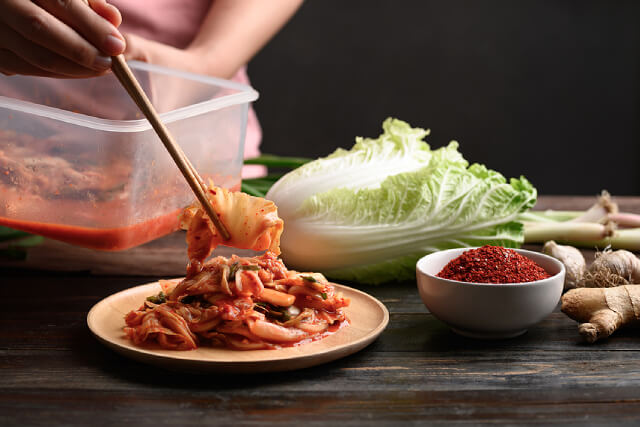Where to start with the reasons why foods are simply amazing? Apart from being the source of sustenance, food opens the gateway to a gastronomic adventure imbued with culture and history. Simply put, food is a more cost-effective way of travelling, without actually spending a hefty amount of money!
If you wish to hop on a gastronomic adventure to the Korean peninsula, start by trying out these 4 iconic Korean dishes!
1. Kimchi (김치)
If we were going to start a list of Korean foods, then it’s only right that we start with the quintessential to any Korean meal: kimchi. Whilst there are many different kinds of kimchi, this dish is made up of vegetables, typically cabbages, fermented in Korean flavours – garlic, ginger and Korean chillies. On top of hitting a range of flavours, there are a variety of uses as well! You can have it as a side dish, a condiment or even an ingredient all on its own!
Kimchi has become such a staple in the Korean diet, it was made to be commercially available for convenience sake. Despite that, there are many who still love to make their own from scratch, based on their own preferences. As with other fermented foods, it will take a little bit of time to put together, but its deep and complex flavours are worth the effort and wait.
2. Bulgogi (불고기)
It’s hard to resist a good barbecue, and Koreans are especially good at this aspect – Korean BBQ a great testament to that. One of their famous Korean beef dishes is the bulgogi, which is simply beef prepared in a sweet and savoury marinade sauce made of sugar, soy sauce and Korean pear juice. This flavourful meat is then grilled alongside various other vegetables such as onions and garlic. Although it can be enjoyed on its own, bulgogi works best when paired with palate-cleansing sides, such as being wrapped in lettuce, or having a side of rice noodles with it.
3. Bibimbap (비빔밥)
One of the most iconic traditional dishes, bibimbap simply translates to “mixed rice with meat and assorted vegetables”. Like kimchi, there are endless variations to this dish depending on one’s dietary requirements and preferences. Even down to the type of bowl it’s served in, such as Korean stone bowl or stainless salad bowl, such small details can make a huge difference!
More traditional and authentic versions of bibimbap are made with raw egg yolk, raw beef, along with other vegetables. That said, many modern recipes now include cooked ingredients to suit more palates.
4. Jjajangmyeon (짜장면)
If you’ve been a fan of Korean dramas and variety shows, you’ll most likely have seen jjajangmyeon appear on the screen once or twice. Dubbed as one of Korea’s most popular dish, you may be surprised to find out that it doesn’t originate from the country. Jjajangmyeon was believed to have been introduced in 1905 by Chinese merchants who had settled in Incheon Chinatown and was later tweaked to suit Korean’s taste buds over time. Since then, it has become Koreans’ ultimate comforting dish.
Starting off with your typical noodles, this dish is served in a black bean sauce, along with pork and various types of vegetables such as zucchinis, onions, and cabbages. Pickled radishes, as well as kimchi, are quite popular ways of fully savouring and enjoying a plate of jjajangmyeon.
For many of us, the best way to happiness is through the stomach! If you are ever curious about Korean cuisines, or even their culture and history, you’ll want to try these 4 dishes as your introductory foods. You can never go wrong with the staples.
If you want to learn more in-depth about Korean culture and history, we can help! At Sejong Korean Language School, we believe that equipping oneself with language skills is the first step to understanding and appreciating a foreign culture and history. In addition to our systematic, structured and engaging teaching methodologies, our teachers are also Korean natives who love doing what they do. So if you ever have any queries about anything Korean, you know who to look for to satiate your curiosity! So, don’t wait and enrol in our Korean language courses today!


